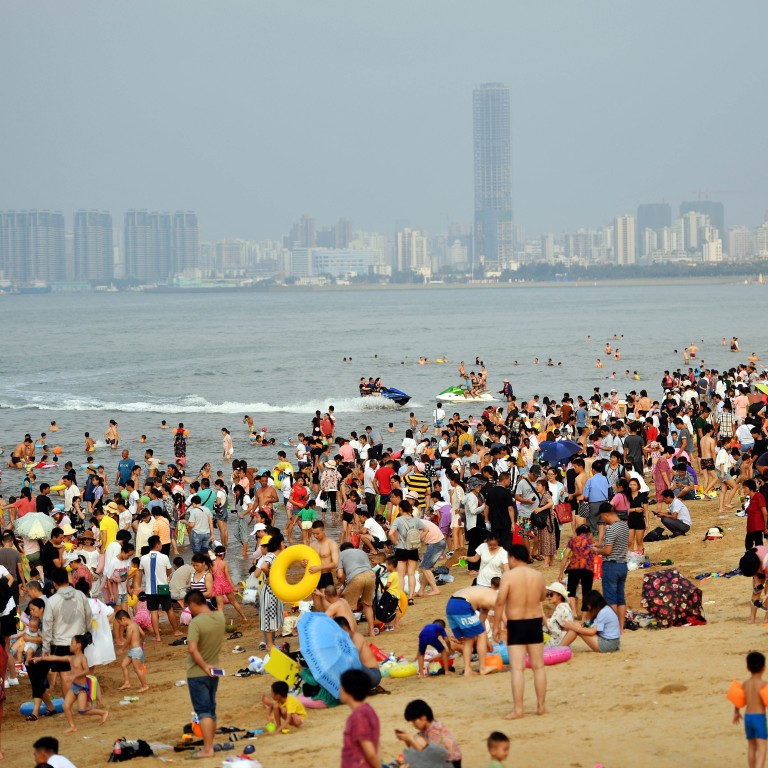
China’s Hainan is benefiting from a domestic tourism boom, but will its moment in the sun last?
- The country’s southernmost province has been touted as an upcoming international destination, despite attracting only a few arrivals from overseas
- Coronavirus-related restrictions have caused an influx of Chinese tourists keen to spend in duty-free stores
Not that Hainan has been lacking in visitors. According to Chinese tabloid the Global Times, “More than 83 million tourists from home and abroad visited southern China’s tropical island province of Hainan in 2019, up nine per cent year on year.” Tourism revenue also increased, rising 11 per cent to 105 billion yuan (US$16.2 billion), although noticeably absent from the article was the breakdown of domestic and foreign visitors. In 2018, non-Chinese visitors to the island had accounted for just 1.2 per cent of its 76 million arrivals.
But then, of course, the pandemic hit. From midnight on March 28, 2020, China closed its borders to foreign nationals, and entry bans remain in place for all but those with residence permits.
However, unlike all those desirable overseas destinations Hainan was designed to emulate – Indonesia’s Bali or Phuket, in Thailand, for example – the “Hawaii of China”, as it is generously called on occasion, has been doing just fine, thank you. Its appeal to domestic tourists has only grown as the world beyond China’s borders continues to be inaccessible.

“Few Chinese destinations benefited as directly from the collapse of outbound tourism in 2020 as Hainan,” reports online platform Jing Culture and Commerce. “As domestic tourism gathered momentum in the latter months of the year, the subtropical island’s comfortable environment and duty-free shopping captured tourists who, in recent years, have sought out regional destinations.”
In December, the province recorded 9.5 million visitors, its second busiest month on record, according to Jing. Then came Lunar New Year and another “surge in domestic travelling”, according to online travel industry publication Travel Daily Media. “According to Haikou Tourism Development Commission, the capital Haikou received a total of 1,171,100 visitors during the seven-day holiday, raking in 1.291 billion [yuan],” reports the platform.
Duty-free stores in Hainan have also gained from Chinese tourists’ inability to travel internationally. “Last year the government eased restrictions on such purchases as more Chinese tourists [...] flocked to the island, providing a lifeline for the global industry,” reports Bloomberg. Jean-Marc Pontroué, chief executive of luxury watchmaker Panerai, told the news agency that duty-free sales in China “have been extremely solid in the last 12 months”.
Who needs international arrivals, anyway?
Sure, but conventional wisdom suggests that achieving such standing will take more than just repeating the desire for it. “The quality of Hainan’s tourism products has not yet reached an international, first-class level,” professor Yuan Guohong, the head of Hainan University’s School of Hospitality and Tourism Management, told the Post last year.
Then there is the possibility that once Chinese tourists can leave the country, they will, returning to those regional destinations they once preferred over Hainan. If so, China’s Hawaii might have to pack away its beach towel and retreat from its moment in the sun.
Indonesian island of Bali prioritises tourism workers for Covid-19 vaccines

Unlike Hainan, the resort island of Bali has been left reeling by an almost complete absence of international travellers. However, hopes of a recovery for the Indonesian hot spot’s tourism industry are growing with the arrival of not visitors, but vaccines.
On February 27, a drive-through vaccination centre was opened at the Bali Nusa Dua Convention Centre, in Denpasar. It is hoped that more than 5,000 tourism, public transport and ride-hailing service workers will be given their jabs each week.
According to Indonesian news site Tempo, tourism minister Sandiaga Uno identified tourism workers as a priority group.
Online news platform Coconuts Bali reports that Bali Governor Wayan Koster, who attended the centre’s launch, “expressed hope that this programme will accelerate the recovery of Bali’s decimated tourism industry”.
TripAdvisor reviewers rank Asia’s top 25 beaches

Another week, another list from TripAdvisor – this time of Asia’s top 25 beaches, according to the online travel platform’s users. India’s stretches of sand score particularly highly, with Goa’s Agonda and Cavelossim beaches taking the top two spots, respectively. In third place is Ngapali, in Myanmar. “Three kilometres of beach without a soul to be seen,” writes one reviewer; coronavirus coupled with the country’s recent military coup are likely to keep it that way.
Beaches in Indonesia, Japan, Bangladesh, Sri Lanka, Thailand, South Korea, the Philippines, Malaysia, Vietnam and on the Andaman and Nicobar Islands also feature.
We’re assuming Hong Kong’s absence is all down to the fact its coastline is effectively closed …

